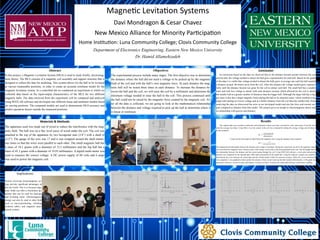
EET Poster
- 1. Magnetic Levitation Systems Davi Mondragon & Cesar Chavez New Mexico Alliance for Minority Participation Home Institution: Luna Community College; Clovis Community College Department of Electronics Engineering, Eastern New Mexico University Dr. Hamid Allamehzadeh Abstract In this project, a Magnetic Levitation System (MLS) is used to study briefly, electromag- netic theory. The MLS consists of a magnetic coil assembly and support structure that is designed to collect the data for modeling. This system allows for the ball to be levitated at various measurable positions, in order to create an accurate nonlinear model for the magnetic levitation system. In a controlled lab we conducted an experiment in which we collected data based on the input-output characteristics of the MLS for two different magnetic balls. The data retrieved from the experiment will be compared and analyzed using MATLAB software and developed into different linear and nonlinear models based on varying positions. The computed models are used to demonstrate MLS accuracy and predict operation factors outside the measured positions. Conclusion In conclusion based on the data we observed that as the distance became greater between the coil and the ball, the voltage needed to attract the ball grew exponentially for each ball. Based on the graph of the data it is visible that voltage needed to attract the balls grew at average rate until the ball reached a distance around .06 meters away from the coil. After this distance the voltage needed grew exponen- tially until the distance became too great for the coil to attract each ball. The small ball has a smaller mass and took less voltage to attract with each distance increase which allowed for the coil to attract the smaller ball at a greater number of distances than the bigger ball. Although the larger ball has a big- ger mass it also has a larger magnetic field causing the ball to be attracted easier, which resulted in the larger ball starting at a lower voltage and at a farther distance from the coil than the smaller ball. From analyzing the data we discovered the error in our developed model and also the force and current out- puts compared to distance from that model. This project gives an insight to electromagnetic theory and its relationship with gravity and distance. Objectives The experimental process include many stages. The first objective was to determine the distance where the ball did not need a voltage to be picked up by the magnetic field of the coil and with the ball’s own magnetic force. At each distance the mag- netic ball will be tested three times at each distance. To increase the distance be- tween the ball and the coil, we will raise the coil by a millimeter and determine the minimum voltage needed to raise the ball to the coil. This process continued until the ball could not be raised by the magnetic force created by the magnetic coil. Af- ter all the data is collected, we are going to look at the mathematical relationship between the distance and voltage required to pick up the ball to determine where it is linear or nonlinear. Materials & Methods The apparatus used was made out of wood to reduce the interference with the mag- netic field. The ball was on a flat, level piece of wood under the coil. The coil was attached to the top of the apparatus by two hexagonal nuts (3/4”) with a shaft of (1/2”). The gauge of the wire was 17 and it was wrapped around the shaft numer- ous times so that the wires were parallel to each other. The small magnetic ball has a mass of 10.1 grams with a diameter of 12.5 millimeters and the big ball has a mass of 45.3 grams with a diameter of 19.03 millimeters. A digital multi-meter was used to measure the correct voltage. A DC power supply of 60 volts and 6 amps was used to power the magnetic coil. Results The original data was recorded in millivolts and millimeters which were later converted to volts, and meters. From the three trials the average was taken. Using Ohm’s Law the current in the coil was computed by taking the average voltage and dividing it by the resistance. Using current and weight we determined the magnetic force using the magnetic force equation. The mathematical relationship between the distance and voltage is nonlinear. During the experiment not all of the supplied voltage was converted into magnetic force, because some of the energy was lost due to the heat generated in the coil. The first graph shows the relationship between the distance and the current going through the coil. Using MATLAB software a sixth order polynomial function was computed for the big ball and a fifth order polynomial for the small ball. Using the software a graph was created to demonstrate the error between the actual data and the created model within five percent accuracy. When the correct polynomial was computed, it was graphed to better predict the amount of force need to pick up the ball outside collected data. A 3D graph was generated with force, current in amps, and distance in meters to better visualizes the relationship between all the three variables. Implications System involving electromagnetic en- ergy provide significant advantages in the real world. This is so because mag- netic fields can offer a frictionless ap- paratus that can be used for bearings and levitating trains. Electromagnetic energy can also be used in other field such as micro-positioning, vibrating isolation tables, and magnetic space launch systems.
